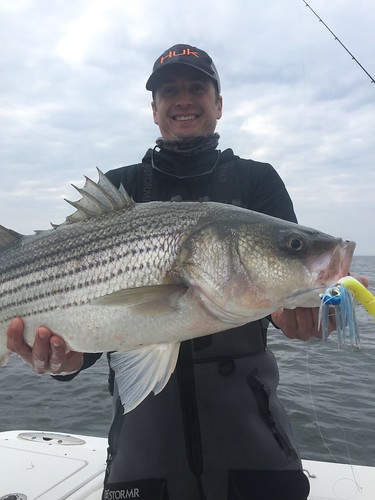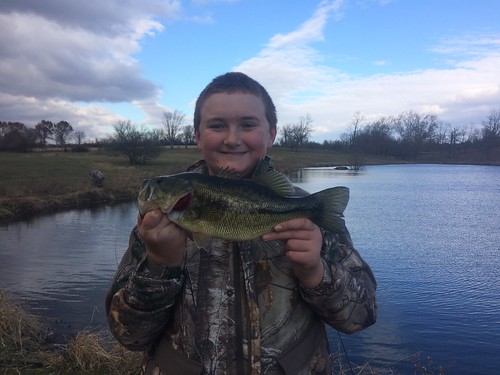By: Keith Lockwood
Despite chilly temperatures and some pesky wind, on mild days this is a wonderful time to do some fishing whether on the bay, a favorite lake, pond or tidal river. There is still some color in the trees and the fish are still biting. Make an effort to get out, even if for a short spell, before the holiday rush gets too crazy and winter's grip tightens.
Fishing in the lower Susquehanna has been slow this week for striped bass and other species due to the lack of power generation water releases from the Conowingo Dam. Out at the mouth of the Susquehanna and Elk Rivers striped bass fishing has also been slow with the only action coming from the deepest parts of the channels. Yellow perch are beginning to show up in the lower sections of the rivers in the upper bay region and providing some action and good eating.
Farther down the upper bay, cold water temperatures are turning the striped bass action dial to lower readings as the fish begin to hunker down in the deeper parts of the channels. Some are still feeding but it takes patience and a lot of lead in the form of inline weights to get bucktails down to where the fish are suspended if you are trolling. Jigging can still be productive and soft plastics or metal jigs will get the job done if you can find some cooperative fish. There continues to be a lot of small fish around but some real whoppers are being caught also. The action in the tidal rivers such as the Patapsco, Gunpowder, Magothy and Chester has been reported to be slow lately but there is hope it will pick up again. Water temperatures are hovering around the 50° mark this week and once they fall into the low 40's most striped bass will hunker down to sit out the winter in the deepest parts of the channels that have sufficient oxygen levels and slightly warmer water temperatures.
The Bay Bridge is always a late season draw and fish will be found suspended at the rock piles and bridge abutments holding close to the bottom. Jigging is the best way to get to them and soft plastics often outperform metal in this situation. Small heavy metal jigs are a good bet when fishing at the rock piles for white perch.
In the middle bay region there continues to be scattered striped bass action and all of it tends to be in very deep water, 50' or more. The deeper channel edges of Kent Island are usually a great place this time of the year to find schools of striped bass and white perch holding close to the bottom. The mouth of the Choptank and Little Choptank have been providing good reports this weekend for those jigging deep. Josh Kaltreider holds up a nice one he caught recently near the Gooses in about 50' of water.

Photo courtesy of Travis Long
White perch are also holding in the deep waters of the major channels in the region, often in 50' of water and holding close to the bottom. Hard bottom is a key and a jig with a dropper fly is a good way to get down to them. If the drift is too fast or currents too strong a medium-sized sinker with two dropper flies is a good bet. Tipping those dropper flies with a small piece of bloodworm will increase the odds of success.
In the lower bay region fishing for striped bass has been good with decent size legal fish being caught throughout the region. As would be expected most of the action is deep but occasionally there has been some action on top. Concentrations of baitfish to attract and hold striped bass are the key factor for success as we move into the last month of the season. The lower bay region is the last stop for baitfish schools as they head south into Virginia waters, and most of the action was in that region last year, in December of 2015. Sea gulls and gannets have been marking the way to much of the action and usually when gannets are involved the baitfish are fair sized and thus the striped bass are also. Channel edges at Buoy 76, the HS Buoy, Buoy 70, 72A, Cove Point and the Targets have been some of the better places to find action. The lower Patuxent and Potomac have also been providing good fishing. Vertical jigging with larger soft plastics cuts down on dealing with smaller fish and trolling bucktails with heavy inline weights has also been effective.
The last month of the Chesapeake Bay striped bass season is when hopeful anglers look for large fall migrant striped bass that make a right hand turn up the Chesapeake on their fall southerly migration. Rumors abound of a few large fish being caught just south of us at the Cut Channels but so far the action has yet to develop to any degree in Maryland waters. The bulk of the migration tends to be out in the EEZ area right now off southern New Jersey but there was some exciting action off southern New Jersey beaches over Thanksgiving, so maybe some fish will come this way in early December.
Those who wish to put some tasty fillets in their freezers for the winter months have been targeting white perch in the lower Patuxent and Nanticoke Rivers in about 50' of water over good oyster bottom. Jigging and fishing with bottom rigs baited with pieces of bloodworm have been the way to fish for them. Also anchoring up along channel edges in the tidal Potomac from the 301 Bridge to the Wilson Bridge and bottom fishing with cut bait is a great way to fill a cooler with a mess of medium-sized blue catfish. Alvie Sickle holds up a nice blue catfish destined for the freezer.

Photo courtesy of Jim Gronaw
Freshwater fishing in the western region is still going strong but due to colder water temperatures, tactics are changing. Water temperatures are in the 40's now in most areas and if fish can go deep to find slightly warmer water they will. At Deep Creek Lake there has been good fishing for yellow perch in about 40' of water working small jerkbaits and silver buddies slow and close to the bottom. Walleye are also very active and can be caught on similar lures.
Smallmouth bass and walleye fishing in the upper Potomac River has been fairly good but fishing has been hampered by low flows in the river and loose grass and fallen leaves fouling lines. Tubes and small crankbaits have been good choices for lures. Trout fishermen are also dealing with low flows but like the smallmouth bass and walleyes; they have to be somewhere so targeting the deeper pool areas and channels is a good bet. Small spinners and spoons are good bets for spin casters and wooly buggers and nymphs for fly casters.
Largemouth bass are moving into deeper waters due to colder water temperatures and the mantra tends to be "deep, slow and small". Fish small lures like silver buddies, crankbaits, grubs and jigs close to the bottom and let them almost sit on the bottom and twitch and retrieve slowly. Targeting deep structure such as sunken wood, rocks, bridge piers and deep grass is always a good bet this time of the year. Caleb Mutchler got to do a little fishing with his dad and grandfather and enjoyed catching and releasing some largemouth bass.

Photo courtesy of Caleb Mutchler
Crappie are schooling up, suspended near deep structure. Marina dock piers, bridge piers and fallen tree tops are all good places to look. Minnows or small jigs under a slip bobber is a good way to fish for them. Channel catfish and blue catfish are active and can be found in deeper waters. The channel catfish are found in most of the tidal rivers flowing into the Chesapeake and blue catfish tend to dominate the tidal Potomac River.
Oceanside anglers at the Ocean City beaches and near shore shoal areas are anxiously waiting for the southerly striped bass migration to hit the Maryland beaches. This could be the weekend that it happens. A large body of striped bass hit the southern beaches in New Jersey over Thanksgiving in an old fashioned blitz situation where menhaden were driven up onto the beaches and fish were caught on almost every cast. A few striped bass are presently being caught off the beaches and on the near shore shoal areas.
There has also been plenty of action in the inlet and Route 50 Bridge area, many are coming up short but it is good fun catching them. Casting plugs, swim shads, bucktails or drifting live eels or cut bait have been favored ways to fish. There are a lot of tautog being caught in the area but the throwback ratio is high but still a lot of fun.
Boats have been crisscrossing the shoal areas off the beaches in search of migrating striped bass and bluefish. Most are trolling a mix of umbrella rigs, bucktails and Stretch 25 lures. Farther offshore limit catches of tautog and sea bass are fairly common at the wreck and reef sites. A few medium-sized bluefish and flounder are still being caught and spiny dogfish are beginning to show up at the sites.
Boom...Morgan
No comments:
Post a Comment